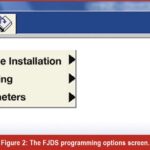ISTA, BMW’s Integrated Service Technical Application, is a comprehensive diagnostic and programming software used by technicians to troubleshoot and maintain BMW vehicles. One crucial function of Ista For Bmw is its ability to detect engine tuning modifications, commonly referred to as “tunes” or “flashes.” This article delves into the intricate process ISTA utilizes to identify these alterations.
BMW’s Two-Step Tune Detection Process
BMW employs a meticulous two-step approach to identify tuned vehicles. The initial assessment occurs upon connecting the vehicle to ISTA. The software downloads FASTA data, which contains vehicle specifications and configuration information. This data undergoes a preliminary tuning check. If this initial scan raises suspicion, a specific code, TDX03, might be added to the Vehicle Order (VO), similar to Audi’s TD1/TB1/TG1/TE1 process. This flags the vehicle for further investigation.
The second step involves a more comprehensive analysis if the initial check indicates potential tuning. ISTA initiates a detailed data pull from every module within the vehicle using the ABL-DIT-AS1214_TD_BASIC job. This process can take approximately 30 minutes over an ENET connection and may be faster with an ICOM connection. This in-depth scan gathers extensive data points for subsequent evaluation.
Analyzing ISTA Log Files for Tuning Detection
After the data collection is complete, ISTA compiles a comprehensive .zip.log data package. This package contains a wealth of log files, the most crucial being the IstaOperation log. This file documents both the initial check in clear text and the raw data dump from the detailed analysis. The initial check log reveals specific criteria examined for tuning suspicion, including:
- CAL-ID and CVN: Calibration Identification and Calibration Verification Numbers for the engine ECU (Electronic Control Unit).
- Fault Memory: Checks for specific Diagnostic Trouble Codes (DTCs) associated with tuning in both the primary and secondary fault memory of the engine ECU.
- Programming Counter: Analyzes the number of times the engine ECU has been programmed, comparing it to a predefined threshold. Frequent reprogramming can indicate tuning attempts.
- Exhaust Temperatures: Examines maximum temperatures in the exhaust line, potentially revealing modifications impacting emissions.
- Plug and Play Suspicion: Evaluates potential use of plug-and-play tuning modules.
- Vehicle Usage Patterns: Calculates the average speed in relation to operating hours, identifying unusual driving behaviors often associated with tuned vehicles.
The raw data section within the IstaOperation log contains a wealth of information in hexadecimal format, requiring specialized knowledge for interpretation. This data is uploaded to BMW’s servers and analyzed using a system called FBM (Fault-Based Management).
Conclusion
ISTA for BMW provides a powerful suite of tools for diagnosing and maintaining vehicles, including a robust system for detecting engine tuning modifications. The two-step process, combining initial checks with detailed data analysis, allows BMW to effectively identify potential tuning. Analyzing the IstaOperation log, particularly understanding the initial check criteria and decoding the raw data, is crucial for comprehending the intricacies of BMW’s tune detection capabilities. Further research and collaboration within the automotive community are necessary to fully decipher the complexities of the raw data and gain a complete understanding of BMW’s tune detection algorithms.


